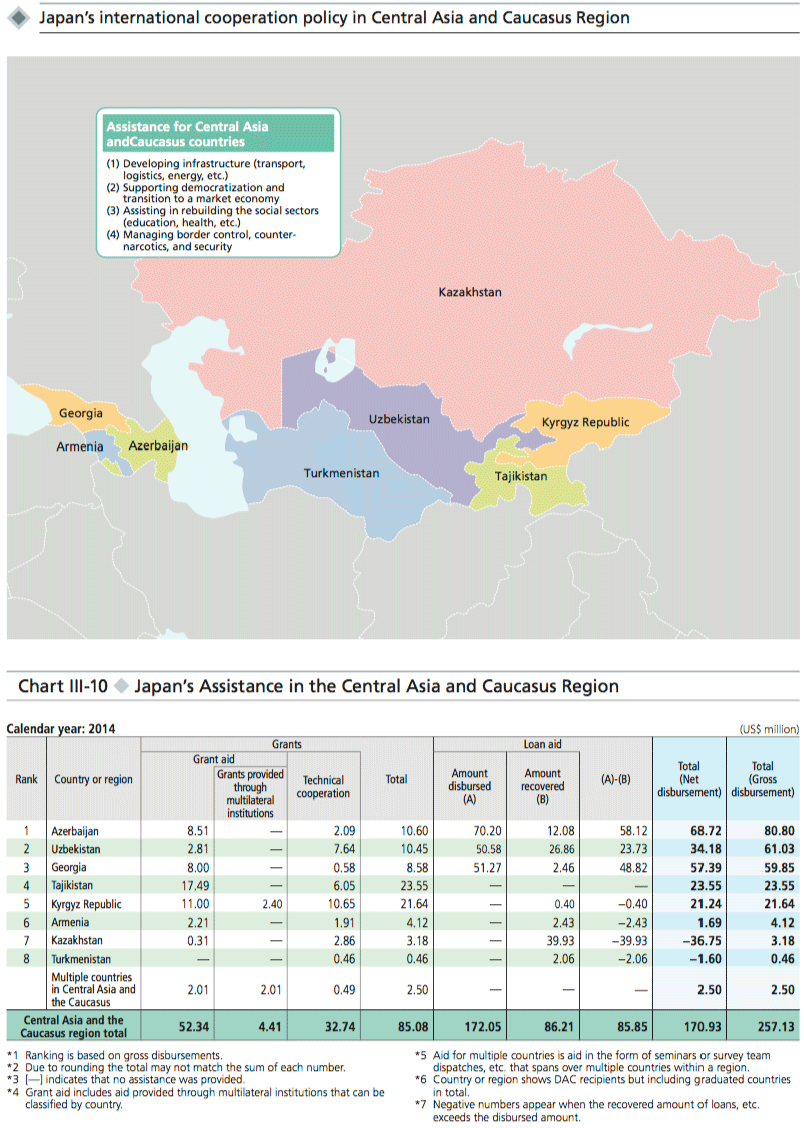3. Central Asia and Caucasus
Central Asia and Caucasus are geopolitically important areas, since they are surrounded by Russia, China, South Asia, the Middle East, and Europe. As these regions include countries with a large abundance of energy and mineral resources such as oil, natural gas, uranium, and rare metals, they are also strategically important to Japan, which has been promoting resource and energy diplomacy aiming to diversify resource supply countries. For these reasons, the stability and development of these regions are crucial for the stability and development of the Eurasian region as a whole, including Japan. From this perspective, Japan has provided support for nation-building conducive to long-term stability and sustainable development in these regions, with a view to making universal values take root, including human rights, democracy, market economy, and the rule of law, while taking into consideration a broader regional perspective which covers Afghanistan, Pakistan, and other regions neighboring Central Asia.
< Japan’s Efforts >
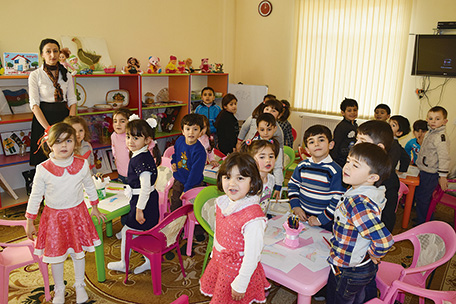
Children study in a kindergarten built through Grant Assistance for Grass-roots Human Security Projects in the village of Mijan in the Ismayilli region of Azerbaijan. (Photo: Hiroshi Seto, Embassy of Japan in Azerbaijan)
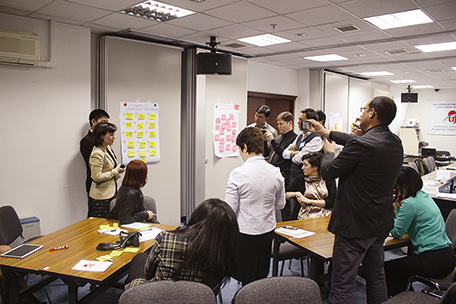
Young people eagerly study at a coaching course for managers at the Uzbekistan-Japan Center for Human Development (UJC) in the capital of Uzbekistan Tashkent. (Photo: Natalya Usharova / Embassy of Japan in Uzbekistan)
In order to facilitate the transition from planned economies to market economies as well as economic development, Japan has conducted a diverse range of assistance activities in such areas as the improvement of legal systems, the rebuilding of health and medical care and other social systems, the improvement of infrastructure for economic development (socio-economic infrastructure), and human resources development for the transition to a market economy. For example, Japan has provided assistance to Uzbekistan in the field of electric power infrastructure. In November 2014, the two countries signed an Exchange of Notes on the ODA Loan, “Electric Power Sector Project Loan,” amounting to ¥86.839 billion. This project loan provides comprehensive ODA Loans to several projects in the same sector, and consists of three sub-projects: (i) Turakurgan Thermal Power Station Construction Project; (ii) Tashkent Thermal Power Cogeneration Plant Construction Project; and (iii) Electric Power Sector Capacity Development Project. It is expected that these sub-projects would increase the stable supply of electric power in Uzbekistan and improve energy efficiency, and contribute to mitigating the effects of climate change through Uzbekistan’s sustainable economic development and reduction of natural gas consumption and CO2 emissions. Furthermore, Japan Centers* in Uzbekistan and the Kyrgyz Republic have contributed to human resources development that can respond to the transition to market economies by providing business courses and other activities based on Japan’s experiences. Some of the largest oil fields in the world have been found in the Caspian Sea coast of Kazakhstan and Azerbaijan where Japanese companies also have interests. The stability and economic development of the region are important for stabilizing the international energy market as well as for securing the energy resources of the international community. Japan has provided assistance to the region, including support for the improvement of public services, human resources, and infrastructure like power plants.
Moreover, Japan established the framework of the “Central Asia plus Japan” Dialogue in 2004 to promote regional cooperation in Central Asia. It has conducted dialogues and facilitated cooperation at a variety of levels, including foreign ministers’ meetings and senior officials’ meetings. In July 2014, the tenth anniversary of the Dialogue, the fifth foreign ministers’ meeting was held in the Kyrgyz Republic, and discussion took place regarding such fields as agriculture, anti-drug measures and border control, and disaster risk reduction.
In October 2015, Prime Minister Shinzo Abe visited the five Central Asian countries, and unveiled the following three pillars of Japan’s foreign policy towards Central Asia: dramatic strengthening of bilateral relationships; involvement in efforts to resolve challenges common to the countries in the region; and partnership on the global stage. In particular, in regard to development cooperation, Prime Minister Abe announced Japan’s cooperation tailored to the development challenges of each country, including development of socio-economic infrastructure such as roads, airports, and medical facilities. Additionally, this cooperation consists of human resources development that includes support for training people who lead advanced industries by making use of Japan’s engineering education such as technical colleges. Japan confirmed that it would continue to cooperate on the main themes of the “Central Asia plus Japan” Dialogue, such as border control, anti-drug measures, and agriculture.
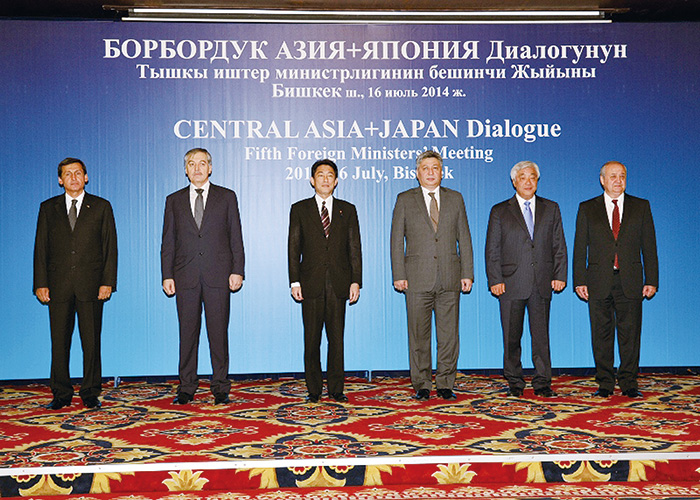
Foreign Minister Fumio Kishida participates in the Fifth Foreign Ministers’ Meeting of “Central Asia plus Japan” Dialogue held in Bishkek, Kyrgyzstan, in July 2014.
- *The Japan Center
- There are ten Japan Centers in nine countries, which aim to develop human resources to support the transition to market-oriented economies in countries with transition economies in Central Asia and the Indochina region. Japan Centers serve as a venue to facilitate personal contacts between Japan and these countries, and provide a fine example of “Visible Japanese Assistance.” At present eight centers in seven countries are ongoing as JICA projects (two centers for which JICA projects are completed are also continuing their operations). Their main activities include the provision of business courses and Japanese language courses, and the promotion of mutual understanding.
Afghanistan and Tajikistan
Rural Development Project in Tajik-Afghan Border Area of Gorno-Badakhshan Autonomous Oblast
Technical Cooperation Project (February 2012 – February 2015)
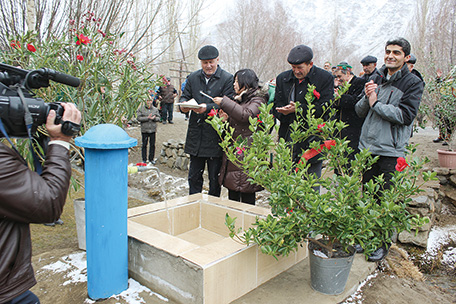
Staff members of the Aga Khan Foundation from the Tajikistan side of the border and representatives of local residents visit Afghani people across the border. (Photo: JICA)
Gorno-Badakhshan Autonomous Region (Oblast) (GBAO) in Tajikistan is located along the border with Afghanistan. GBAO was the poorest agricultural region in the country with the poverty rate significantly above the national average in 2007. Enhanced social infrastructure and basic social services are urgently needed to vitalize the region, as many young people have left the region and become migrant workers, and send money home to help their families survive, which has led GBAO to be less developed than Tajikistan’s urban areas.
In order to resolve such problems, the Government of Japan launched a joint project with the Executive Authority of GBAO. The project aims to promote regional development in the five provinces along the border with Afghanistan, through efforts led by the local people. They also received support from the Aga Khan Foundation, an organization that has been active in the region since the 1990s. They established Associations of the Social Union for the Development of Village Organization (ASUDVO) that are comprised of representatives from the Village Organizations and Social Unions for the Development of Village Organization of each district. In this way, the local people and government have established a system for receiving assistance from Japan.
Japan has helped improve and develop basic infrastructure, develop rural areas, construct roads and bridges, establish social infrastructure, and ensure freedom of movement in GBAO, by taking into account the priorities set by the Executive Authority of GBAO and local communities. Japan is also helping to build a system for providing social services based on the people’s needs, such as human resource development through education, and access to healthcare.
Furthermore, Japan is also supporting GBAO to exchange and interact with Badakhshan Province in Afghanistan, which is located on the other side of Tajikistan’s border. The aim is to encourage consensus-building among the people in the two regions, who share cultural, historical and geographical similarities, when promoting joint development in the regions. Specifically, a cross-border committee was set up to facilitate discussions between the District Coordination Commission on the Tajikistan side and the District Development Assembly on the Afghanistan side, which helps officials on both sides to improve their coordination skills to implement joint development projects.
Japan’s assistance has helped the people of GBAO to implement self-led initiatives to overcome extreme poverty.
